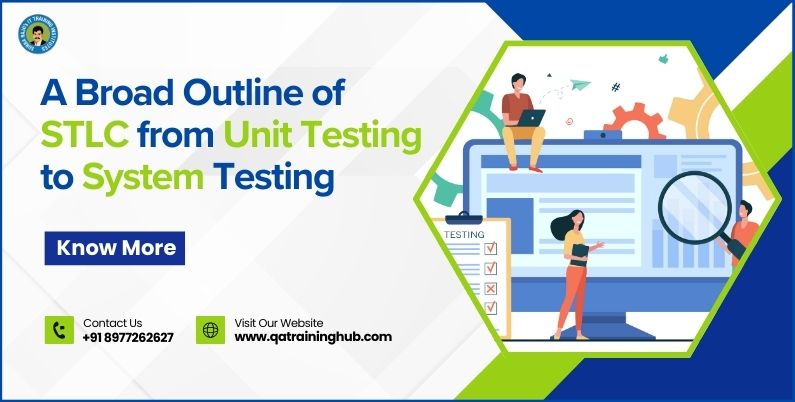A Broad Outline of STLC from Unit Testing to System Testing

The Software Testing Life Cycle (STLC) is a vital framework used by software testers to ensure that a product is developed and delivered without defects. It involves multiple phases, from verifying individual units of code to testing the complete system, ensuring its reliability and functionality. A Broad Outline of STLC from Unit Testing to System Testing is essential for any software tester looking to improve their skills in quality assurance.
At QA Training Hub in Hyderabad, guided by the expertise of Subba Raju Sir, students can gain comprehensive insights into each phase of the STLC, from Unit Testing to System Testing. With practical, hands-on training, learners can confidently master the testing process, preparing them for real-world challenges in the software industry.
In this blog, we’ll explore each phase of the STLC in detail, highlighting the importance of structured testing, how it enhances software quality, and how QA Training Hub can be your go-to resource for becoming a skilled software tester.
Sequence of levels of Testing:
1. Unit Testing
Unit testing is the foundation of the software testing process. It involves testing individual components or units of code in isolation. The primary goal is to ensure that each function works as intended without dependencies on other units. At QA Training Hub, Subba Raju sir emphasizes the importance of mastering unit testing to ensure a bug-free foundation. His expert guidance helps testers develop a strong understanding of writing and executing test cases that validate code at the most granular level.
2. Module Testing
Module testing, often known as component testing, focuses on individual modules or components of the software. After unit testing, the modules are tested as standalone units, ensuring that all the internal functions work correctly. QA Training Hub offers in-depth training on how to isolate and test these components effectively, enabling aspiring testers to handle real-world challenges under the mentorship of Subba Raju sir.
3. Integration Testing
Once individual units and modules pass their tests, they are combined to work as a whole. Integration testing checks the interaction between different modules. The objective here is to identify defects when units are integrated and ensure smooth data flow between them.Mastering integration testing is essential for any tester, and with Subba Raju sir’s expertise at QA Training Hub, you’ll learn how to detect interface issues and ensure seamless communication across software modules.
4. System Testing
System testing is a holistic approach to verify the entire application in an integrated environment. It examines both functional and non-functional aspects of the software, ensuring that it works end-to-end, just as the user expects. At this stage, testers simulate real-world conditions and validate whether the system meets its requirements. Subba Raju sir’s experience in system testing offers insights into testing in real-world scenarios, ensuring testers are well-prepared for challenges.
The Role of QA Training Hub and Subba Raju Sir in Your Testing Journey
Mastering the various stages of the Software Testing Life Cycle is essential for anyone pursuing a career in software quality assurance. With the guidance of industry experts like Subba Raju sir and comprehensive training at QA Training Hub, you’ll gain the skills and knowledge needed to excel in your testing career.
QA Training Hub offers specialized training on each phase of the STLC, from Unit Testing to System Testing, with hands-on experience, real-world case studies, and mentorship from seasoned professionals like Subba Raju sir. His expertise ensures that you’re prepared for complex testing scenarios in today’s competitive software industry.
Phases in the Software Testing Life Cycle (STLC)
The Software Testing Life Cycle (STLC) follows a structured sequence of phases, ensuring that every aspect of a software product is tested thoroughly for functionality, performance, and quality. At QA Training Hub in Hyderabad, Subba Raju Sir emphasizes the importance of mastering each phase, preparing students to excel in their software testing careers.
Here are the critical phases in the STLC:
Test Initiation
This is the starting point of the testing process. It involves gathering requirements, understanding the scope, and defining the objectives for testing. Subba Raju Sir provides deep insights into how to approach the initiation process efficiently through his popular Subba Raju Sir Videos.
Test Planning
In this phase, the test strategy is formulated, and resources, tools, and timelines are defined. Effective planning ensures the testing process runs smoothly, with a focus on identifying risks and mitigation strategies.
Test Design
Test cases and test data are prepared based on the software requirements. This phase ensures that all possible scenarios are covered to detect any bugs or defects. At QA Training Hub, Subba Raju Sir teaches the best practices for creating effective test designs, enhancing both functional and non-functional testing skills.
Test Execution
Test cases are executed in this phase, where actual testing takes place. The results are logged and compared with expected outcomes to identify any deviations. Subba Raju Sir explains the critical role of execution in detecting defects early on through detailed Subba Raju Sir Videos.
Result Analysis
Once test execution is complete, the outcomes are analyzed to determine the software’s stability and readiness for the next phases. This stage involves identifying any failures and understanding their impact on the system.
Bug Tracking
All detected bugs are tracked and documented, providing insights into the software’s weaknesses. QA Training Hub in Hyderabad teaches effective bug tracking methods, ensuring testers can communicate issues clearly with development teams.
Bug Reporting
Testers report bugs with detailed descriptions, including steps to reproduce them and their severity. Subba Raju Sir demonstrates how to create thorough bug reports that help developers resolve issues swiftly, as shown in his informative videos.
Test Closure
In the final phase, the testing process is reviewed, and a test closure report is created. This phase evaluates whether all test objectives have been met and what lessons can be learned for future projects.
Conclusion
A Broad Outline of STLC from Unit Testing to System Testing is crucial for anyone looking to build a successful career in software quality assurance. Each phase, from Test Initiation to Test Closure, plays a critical role in ensuring that the software is free from defects and meets the necessary standards. At QA Training Hub in Hyderabad, under the expert guidance of Subba Raju Sir, students are empowered with the knowledge and practical skills needed to excel in every stage of the STLC.
With Subba Raju Sir Videos offering A Broad Outline of STLC from Unit Testing to System Testing, step-by-step tutorials, you can develop a deep understanding of how to approach software testing efficiently and effectively. Whether you are new to testing or looking to enhance your skills, the right training can elevate your career to new heights, ensuring you are well-prepared to tackle real-world challenges in the software industry.
By enrolling at QA Training Hub, you will not only gain theoretical knowledge but also hands-on experience, helping you become a confident and competent software tester.

